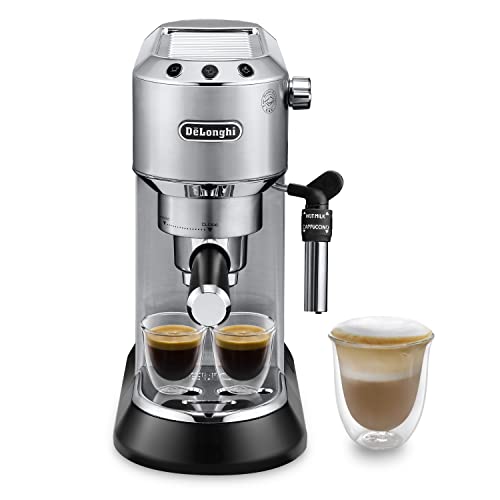What Is It That Makes Espresso Machine Coffee So Popular?

2025-02-21 18:31
82
0
본문
 How to Make Espresso Machine Coffee
How to Make Espresso Machine CoffeeEspresso machines can produce delicious cups, however they require more maintenance and setup than a typical coffee maker. You'll also need to grind and tamp the beans by yourself.
The key to making espresso is pressure. What happens in an espresso machine is that heating vessels heat the water to the perfect temperature before forcing it out of the spouts, and then through the grounds.
Temperature
Espresso is created when hot water is forced under pressure through finely roasted coffee. The temperature of the water is crucial to the final shot. Low temperatures can cause lack of flavor compounds. The high temperatures cause excessive extraction and can cause burnt or bitter tastes.
The ideal temperature for espresso is between 195 and 205 degrees Fahrenheit. This temperature is achieved by using a group head designed to maintain consistency and stability throughout the brewing cycle. The E61 is the most well-known group head because it provides temperature stability, pre-infusion capabilities, and lever control.
When altering the espresso machine to accommodate different roasts and brew ratios it is important to consider the impact of temperature on the extraction yield and crema. The ideal temperature will vary on the specific bean and roast but the general rule is that lighter roasts and greater ratios of brew require higher temperatures than dark roasts and lower brew ratios. A high-quality espresso machine thermocouple is vital to maintain the temperature at a constant level.
Pressure
During the brewing process, espresso machine coffee is pressure-pushed through finely ground and tamped grounds. This causes chemical reactions to extract flavors, oils and other soluble ingredients from the beans. The beverage produced is usually more flavorful and richer.
The ideal espresso machine's pressure is nine bars of pressure which is equal to the atmospheric pressure at sea level. The soluble compounds in the espresso bean are most effectively extracted at this pressure.
However some espresso machines advertise 15 or 20 bars of pressure. Although these machines can achieve these levels of pressure, they may not be able to maintain the pressure during the extraction.
One bar of pressure is equal to 32 pounds per square inch (PSI) of the tire of a car. This is more than four times the pressure that a professional cyclist needs to pump their bike tires. Any serious home barista espresso machine has to be able to control the pressure of their espresso machine, and also produce consistent espressos.
Water
Water is an essential component in a good cup of espresso. The right water will assist your beans in reaching their full potential, espresso machine with Milk frother and the wrong water can cause problems like clogged pipes or even harm your expensive espresso machine.
The best cheap espresso machine option is natural spring water that is high in minerals for optimal espresso extraction. This water will enhance the flavor of your espresso without chalky mineral traces found in tap water or bottled waters. This is a great alternative to distilled or reverse osmosis, that can be too pure and can cause issues with flavor.
However, you should not use filters that remove too many minerals from your tap water, because this could cause problems with flavor and extraction. Get a water test kit to determine the average hardness of the water you drink in your area. This can be used to find an filtration system that can provide you with the right water specs for your espresso machine.
Beans
The majority of coffee enthusiasts become very involved in the whole process of making espresso. They are obsessed with a variety of factors, including temperature, pressure in the water and viscosity. If one of the variables is not functioning properly, the entire shot could taste bad.
The most important aspect when it comes to espresso is the beans used. It is often believed that only certain types of beans are suitable to be used in espresso. While some beans are better suited for certain purposes, any roasted bean can be used to make espresso. Espresso beans are roasted longer than regular coffee beans, tipycally over the second crack. This gives them a darker look and makes them more water-soluble.
The best budget espresso machine beans for Espresso Machine With Milk Frother tend to be medium or dark roasted, which gives the espresso shots their distinctive richness and vigor. Lightly roasted beans can be used to make excellent espresso, especially when they are ground prior to use to make it easier to use an espresso maker.
Milk
Espresso and milk is a classic combination. The combination of milk and espresso is an old-fashioned. It does not only increase energy however, it also balances the bitterness of espresso. There are few culinary duos more perfect than this one!
When you are choosing an espresso machine capable of making latte, or a cappuccino as well it is important to consider how easy it is to use. A majority of the top espresso machines come with a jug of hot or cold coffee and a steam wand. They also come with a portafilter for pulling the shot. Some models come with an integrated grinder, tamper, and frother.
The steam wand needs to be cleaned prior to using it for the first time in a day (or after each cup of espresso) to get rid of any water that has condensed. This process will take around 30 seconds and is important to ensure your machine is running smoothly. If you don't cleanse this process, it could lead to bitter taste or a buildup of bacteria that can alter the taste or odor of your beverage. It's not difficult to do and should be part of your routine maintenance.

댓글목록0